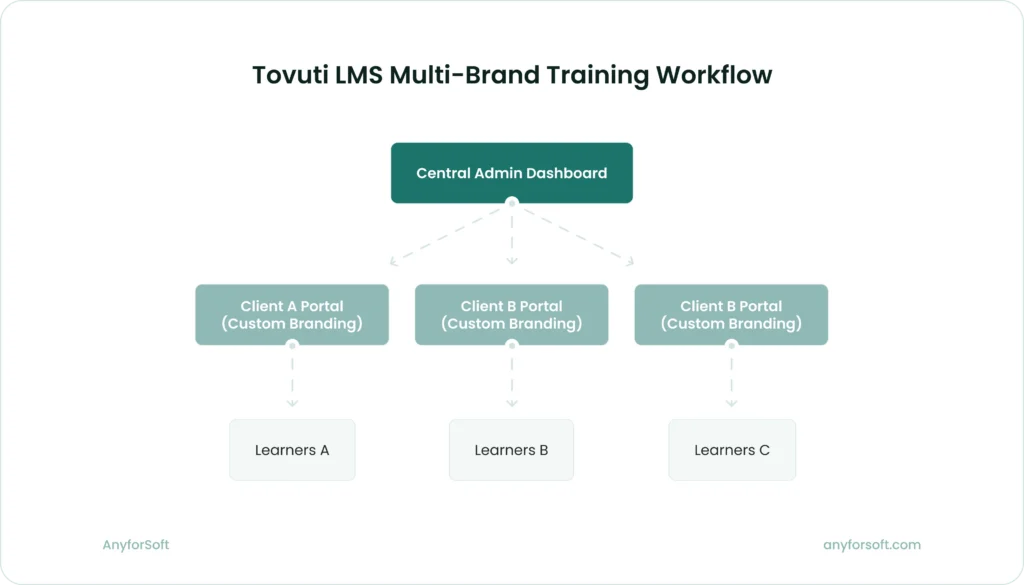Choosing an LMS often reveals a hard truth: platforms that look promising in evaluation can struggle once deployed.
This article examines Tovuti LMS, a mid-market platform launched in 2017, to identify where it excels and where it falls short. The focus is practical, centered on questions that determine fit:
- What does Tovuti LMS actually do well?
- Where do organizations encounter recurring limitations?
- Which factors separate successful implementations from failed ones?
- How can decision-makers evaluate whether Tovuti LMS matches their organizational profile?
Tovuti positions itself as an all-in-one platform: combining content authoring, built-in libraries, gamification, integrations, and multi-tenant branding. User feedback suggests these claims hold weight in specific contexts, particularly mid-sized organizations needing fast implementation or standardized training content. At the same time, patterns of frustration emerge around integration depth, large-scale operations, and customization boundaries.
The objective here is not to declare Tovuti universally strong or weak. Instead, the analysis maps the conditions under which its design delivers genuine value.
Understanding both sides of this equation—capabilities and constraints—creates the foundation for the evaluation that follows. Strengths matter, but boundaries matter just as much.
Before evaluating where Tovuti LMS succeeds or struggles, it is essential to understand what the platform actually includes and how it positions itself in the market.
What Tovuti LMS Offers
Tovuti, launched in 2017, is a cloud-based learning management system. Its most effective range lies with mid-sized organizations. Recent Tovuti reviews on G2 and Capterra highlight high ease-of-use scores alongside recurring comments: 4.6 out of 5 on G2 (based on ~294 reviews as of 2025) and 4.8 out of 5 on Capterra (99 reviews).
Key Tovuti LMS’s features can be summarized as follows:
| Capability | Description | Practical Value |
| Built-in Authoring Tools | 40+ interactive content types for courses | Removes the need for external authoring software |
| Content Library (BizLibrary) | Thousands of ready-made compliance and professional courses | Enables rapid deployment of standard training |
| Virtual Classrooms | Integrated web conferencing tools | Supports blended and instructor-led learning |
| Multi-Tenant Branding | Separate branded portals within one system | Cost-efficient for franchises, resellers, or multi-client setups |
| Gamification | Points, badges, and leaderboards | Boosts learner motivation and course completion |
| Mobile Applications | Native iOS and Android apps | Provides training access across devices and locations |
| Integrations | Direct: Salesforce, BambooHR, Workday; Middleware: Zapier (7,000+ apps) | Connects LMS with HR and business tools; depth varies |
| Deployment Model | Cloud-based SaaS | Scalable, subscription-based structure |
| Implementation Timeline | Ranges from weeks to several months | Adapts to organizational complexity and migration needs |
The platform operates on a subscription model, with pricing tiers based on features and user count (exact pricing is available only through direct inquiry). The cost structure, which is typical, scales with organizational size and selected capabilities.
Implementation speed varies: straightforward deployments have been reported within weeks; complex setups involving large content migrations or integrations may extend into several months.
Understanding what Tovuti LMS includes and how it positions itself in the market establishes the baseline. The next step is to examine how these capabilities translate into real strengths when applied in organizational contexts.
Where Tovuti Works Well
Tovuti delivers measurable advantages in mid-market scenarios. This section surfaces Tovuti pros and cons within them.
Fast implementation with minimal technical resources
Tovuti’s interface is designed to shorten the learning curve for administrators without technical backgrounds. Built-in authoring and configuration tools remove the need for separate course software, reducing both cost and integration complexity.
Implementation timelines consistently move faster than on platforms that require extensive configuration. Organizations report going live within weeks instead of months, a difference that becomes critical when training must respond quickly to new regulations or urgent operational needs.
User feedback supports this pattern.
A corporate manager noted that after a straightforward setup, they could “upload and create content very easily.” Another reviewer, a project manager, described the system as “very intuitive for staff training,” reinforcing its appeal for organizations that lack dedicated technical resources.
Leveraging pre-built content
Tovuti enables organizations to deploy training programs almost immediately by drawing on a large integrated content library. Thousands of pre-built modules cover compliance, leadership, onboarding, and professional skills, reducing reliance on lengthy in-house development.
The platform simplifies adoption in two practical ways:
- Bulk import tools allow administrators to bring in multiple courses at once, saving significant setup time.
- Flexible assignment options let teams deliver imported modules as standalone courses or embed them into broader sequences.
As an e-learning industry representative emphasized,
“The platform made it simple to design interactive courses, customize materials from its built-in library, and incorporate multiple file formats without difficulty.”
Tovuti extends these options with its “Bring Your Own Content” feature, which supports SCORM files, multimedia, and existing company documents. This balance of pre-built and custom materials reduces the need for specialized authoring expertise, at the same time, enabling organizations to adapt content to their context. Unlike platforms that require separate authoring software, Tovuti integrates creation directly. The platform includes 40+ interactive content types and an AI assistant. As a result, administrators can combine library modules with custom Tovuti courses created via the built-in authoring tools, crafting learning materials within minutes.
This approach is most effective when the majority of training falls into standardized categories. If 60 to 80 percent of an organization’s content needs involve onboarding, compliance, or professional development, the library covers the bulk of requirements while leaving only niche topics for custom design.
In such cases, Tovuti’s model delivers speed, coverage, and cost savings in equal measure.
Key capabilities for leveraging pre-built and imported content in Tovuti LMS
| Capability | Description | Practical Value |
| Integrated Content Library | Access to thousands of professionally developed courses and modules | Enables instant deployment of ready-made training |
| Third-Party Content Integration | Import courses from major content vendors quickly and in bulk | Expands options without authoring delays |
| Bring Your Own Content | Upload SCORM, multimedia, documents, and in-house materials | Combines pre-built with custom content |
| Bulk Import Tools | Import multiple courses or modules simultaneously | Saves time during initial setup and later expansion |
| Easy Course Assignment | Organize modules as standalone courses or within sequences | Supports flexible learning pathways |
Managing training across multiple brands or clients
One platform — many brands. For example, if an organization wants to deliver training to multiple clients, divisions, or partner networks while maintaining distinct branding, Tovuti provides the necessary capabilities. Separate portals can be built for each audience, each with unique logos, domains, and login pages, while all remain connected to a single administrative dashboard. Unlike running multiple LMS instances, this approach keeps management centralized and efficient.
User group hierarchies extend the flexibility. Organizations can create parent–child relationships across clients, locations, or job roles, ensuring learners see only the content relevant to them. Team leaders gain reporting and communication tools restricted to their assigned groups, giving them control without blurring boundaries.
These functions directly support common business models:
- Training resellers managing diverse client portfolios.
- Franchise networks that need consistent content with local branding.
- Staffing companies delivering training across hundreds of sites.
- Partner enablement programs supporting external organizations.
A national provider illustrates this in practice. Managing training for thousands of client sites, they adopted Tovuti specifically for its multi-tenant capabilities. The platform enabled them to offer each client a custom-branded experience while updating content and tracking results centrally, eliminating the overhead of maintaining separate systems.
Key elements include:
- Custom brand manager: Create separate portals for brands, divisions, or clients with unique branding and tailored content.
- Domain and login customization: Provide each audience with custom domains and login pages for a fully white-labeled experience.
- Centralized administration: Manage all portals, users, and reporting from one dashboard.
- Scalable multi-tenant architecture: Add new portals as business expands without additional installations or technical work.

The result is a cost-effective structure that supports many audiences within one platform, combining distinct brand identities with simplified management. In some cases, organizations extend these capabilities through e-learning software development services to address highly specific branding or workflow needs.
Driving learner engagement and completion
Gamification is native to Tovuti’s core platform—points, badges, leaderboards, competitions, and achievement tracking are built in rather than tacked on later. These game mechanics tackle a persistent challenge in corporate learning: low completion rates in mandatory training environments.
Social tools and interactive formats deepen engagement. The Tovuti virtual classroom extends this further by enabling real-time collaboration, live discussions, and interactive instructor-led sessions. Discussion boards, real-time chat, and community zones foster peer interaction. Meanwhile, content types like branching scenarios, simulations, and games outperform static text-and-quiz courses in keeping learners active and invested.
Tovuti also supports personalized learning paths, milestone triggers, and automated nudges to encourage progression. Learners log in to dashboards that surface progress, achievements, upcoming assignments, and announcements. Analytics dashboards offer both learners and instructors insight into engagement levels, drop-offs, and hotspots that may need attention.
Academic evidence supports the link between gamification and stronger outcomes. A meta-study conducted by the National University of Public Service in Hungary found that gamified MOOCs achieved a 13.7% completion rate, compared to 1.7% in non-gamified versions—showing that proper incentives can increase completion severalfold.
| Capability | Description | Practical Value |
| Interactive Content | 40+ content types such as quizzes, polls, and videos | Keeps learners actively involved and attentive |
| Gamification | Badges, leaderboards, achievements | Motivates through rewards and competition |
| Personalized Learning Paths | Automated tailored learning journeys | Enhances relevance and learner commitment |
| Social Learning | Discussion boards, real-time chat, communities | Encourages peer interaction and collaboration |
| Mobile Access | Responsive platform and mobile app | Enables anytime, anywhere learning |
| Analytics & Reporting | Real-time dashboards on learner progress | Tracks engagement and areas needing support |
Organizations that emphasize learner motivation—especially where training is optional or prone to drop-off—see these features solving real pain points. When learners feel rewarded, socially connected, and personally guided, voluntary learning gains traction.
These engagement mechanisms make Tovuti highly effective for mid-sized organizations (approx. 50–5,000 employees) that need fast deployment, use standard training content, or manage multiple brand audiences. Recognizing where it excels is key—but the next chapter explores where it hits structural limits.
Where Tovuti Has Limitations
No LMS delivers everything equally well. In Tovuti’s case, limitations tend to surface in predictable areas: integration complexity, organizational scale, customization boundaries, and data management over time. Understanding these constraints helps decision-makers set realistic expectations before committing.
Integration depth and complexity
While the official Tovuti site lists a wide range of integrations (more than 7,000), practice shows that implementation can be more complex than advertised. Some connections function smoothly, while others require additional middleware or custom development to achieve reliable data flows.
Reviews and analyst commentary highlight recurring Tovuti integration challenges:
- Customization complexity. Implementing integrations within complex environments often requires technical expertise or consultancy support, which increases setup time and cost.
- E-commerce and regional settings. Some users note difficulties configuring multi-currency options, tax compliance, or localized payment gateways, limiting global training and sales scenarios.
- API limitations. The API covers basic tasks but does not support advanced integration needs for proprietary systems or complex reporting. Concerns about long-term stability intensified after a 2024 update deprecated the legacy API, requiring teams to rebuild existing connections.
On one of the Reddit forums, the corporate learning leader described deploying Tovuti successfully for 2,000 employees, only to encounter integration roadblocks as the workforce grew past 24,000. Their HR system required bi-directional data flows for compliance tracking, but Tovuti could only pull data in, not push it back. Engineers spent months attempting workarounds before the organization migrated to another LMS.

Tovuti’s integration challenge highlights the difference between surface-level and enterprise-grade integration. In surface-level setups, Single Sign-On (SSO) only provides login access between systems, so users can enter Tovuti with the same credentials they use elsewhere. In deep integration, data flows both ways: training completions, certifications, and learner progress are automatically synchronized with HR or compliance systems. The first offers convenience; the second delivers business-critical data accuracy.
Scaling beyond mid-market size
Tovuti LMS delivers stable performance in mid-market environments, but its boundaries emerge when organizations scale into enterprise territory. Manual processes that are acceptable with hundreds of users become untenable when populations reach tens of thousands. Tasks requiring a few hours per week at 500 users may demand dedicated staff once learner numbers rise beyond 5,000.
The r/elearning forum, previously mentioned in the context of integration challenges, also illustrates scaling issues. A corporate leader shared that Tovuti supported their workforce effectively at 2,000 employees but faltered once the organization expanded past 24,000. Processes that had worked at a smaller scale could no longer keep pace, showing how hypergrowth can strain the system before its full value is realized.
Recurring scalability concerns include:
- Scaling challenges: Very large user bases, extensive course catalogs, and complex enterprise workflows can create performance slowdowns, increased administrative overhead, or reliance on manual workarounds.
- Global scalability gaps: Support for multi-currency, regional compliance, and localized e-commerce is less robust than in enterprise-focused platforms, which can hinder international rollouts.
- Customization complexity: As organizations expand, effective configuration often requires dedicated IT resources or external consultancy, raising costs and lengthening timelines.
- Reporting and analytics: Mid-level reporting suffices for mid-market use but is inadequate for enterprises that need real-time dashboards and integrations with corporate BI tools.
- Pricing model: Quote-based pricing and add-ons can become expensive at scale, prompting some enterprises to explore custom solutions built by an LMS development company to gain more predictable cost structures.
Independent analysis reflects these realities. While Tovuti markets itself to businesses of all sizes, industry commentary often describes it as a budget-friendly alternative for smaller firms or a strong fit for mid-sized organizations with steady, predictable growth.
Customization boundaries
Tovuti LMS offers strong customization at the surface level—branding, portals, and course layouts—but boundaries appear when organizations need deeper flexibility. White-labeling is effective, yet modifications to core workflows, data structures, or the underlying interface require vendor support or external development resources.
Key customization constraints include:
- Limited source code access. Core system code cannot be modified, restricting specialized features or integrations that go beyond existing APIs.
- UI and workflow constraints. Page layouts and branding are adjustable, but the overall interface structure and learner experience remain fixed. This creates barriers for organizations seeking highly tailored learner journeys or unique administrative processes.
- Vendor dependency. Advanced workflow automation or integration adjustments usually require vendor involvement, which increases both cost and lead time.
- Template-driven design. Content creation relies on predefined templates, which provide efficiency but restrict flexibility for adaptive learning scenarios.
One user, Manager in Professional Services, explained that courses cannot be authored directly in Tovuti. Instead, each element exists as a separate component, requiring work across multiple tabs and careful linking of parts to build a complete course.
These limitations mean Tovuti fits best for organizations that want guided customization within clear boundaries rather than full, code-level control. Enterprises requiring deep flexibility for proprietary processes may need to evaluate complementary software or consider alternative approaches.
Data portability and long-term flexibility
Tovuti LMS addresses immediate training needs effectively, but weaknesses appear when organizations plan for long-term flexibility or potential migration to other platforms. Data portability, integration stability, and vendor dependency become recurring points of concern.
Key limitations include:
- Data export. Learner data, course content, and reports can be exported, but formats are limited. Exports often need cleanup or transformation before use in other systems.
- Proprietary formats. Content relies heavily on Tovuti’s own templates and storage structures. Migrating courses elsewhere often means re-authoring or converting them.
- API constraints. While APIs allow basic access, bulk extraction or advanced enterprise reporting is restricted. This becomes critical for BI integration or large-scale migration projects.
- Vendor lock-in. Deep investment in Tovuti can create dependency. Subscription increases, migration complexity, and reduced leverage in negotiations all contribute to long-term risk.
- Adaptability. The platform’s roadmap and architecture may not fully keep pace with new learning standards or enterprise requirements without vendor involvement.
Several reviewers on TrustRadius noted that pulling aggregate analytics from features such as forum participation or interactive video responses was challenging. These concerns point to limits in both data export and summary reporting usability.
Organizations evaluating Tovuti should validate exactly which data formats are exportable, whether exports are editable, and what exit costs would look like if migration becomes necessary.
Understanding these limitations helps decision-makers judge whether Tovuti’s data boundaries align with their future plans. The next step is to apply this analysis in specific organizational contexts, where strengths and weaknesses translate into practical choices.
Where Tovuti Fits — and Where It Doesn’t
Evaluating organizational fit depends on whether Tovuti can cover essential LMS requirements such as scalability, reporting, and integration depth. When these fundamentals align with company size and training goals, the platform works well; when they do not, misalignment becomes visible quickly.
Organizations where Tovuti Succeeds
Tovuti is most effective for mid-sized organizations that prioritize fast implementation, straightforward integrations, and a structured approach to training. Companies with 50 to 5,000 employees and predictable growth patterns often find its balance of features well matched to their needs. In such contexts, administrators usually want a platform operational within weeks, not months, and rely on cloud-based HR or productivity systems that connect easily through single sign-on and basic provisioning.
The platform’s strengths align particularly well with standardized training requirements. Many mid-market firms focus on compliance, onboarding, and general professional development—areas where pre-built content libraries and built-in authoring tools reduce the need for expensive custom development. Internal learning teams can manage course creation directly, taking advantage of interactive templates and gamification without needing specialized technical support.
Branding flexibility adds another layer of value. Multi-tenant portals allow training providers, partner programs, or franchise networks to deliver distinct branded environments while maintaining centralized content control. This makes Tovuti appealing to organizations that want consistency at the core, but variation at the edges.
Examples of success often fall into recurring patterns:
- Standardized onboarding programs where every new hire follows the same curriculum.
- Compliance training with certificate tracking.
- Training providers serving multiple client portfolios with branded portals.
- Partner enablement programs where external organizations need product or process knowledge.
In these scenarios, ease of use and learner engagement outweigh the absence of predictive analytics or highly customized workflows. Too much flexibility can sometimes be as limiting as too little; for organizations that simply need dependable delivery, Tovuti’s structured model works to their advantage.
Warning indicators of potential misalignment
The same traits that make Tovuti appealing in mid-market contexts become stress points at enterprise scale. When user populations exceed 10,000 or growth accelerates rapidly, manual processes that once seemed manageable multiply exponentially. What functions smoothly at 2,000 users buckles under the weight of 10,000.
Integration requirements amplify these issues. Companies with complex HR ecosystems—those using UKG, Kronos, or multiple systems of record—often need professional LMS integration services to establish stable, bidirectional data flows with payroll, credentialing, or compliance databases. Tovuti’s reliance on surface-level integrations does not extend this far, and attempts to build custom bridges can prove costly.
Industry specificity introduces another fault line. Healthcare organizations tracking simulation hours, manufacturers certifying operators on critical equipment, or financial firms bound by unique data retention rules often discover that Tovuti’s template-driven approach cannot accommodate their requirements. In such settings, organizations often evaluate Tovuti competitors positioned for deeper HR connectivity and domain-specific compliance.
Scenarios where misalignment becomes visible include:
- Rapidly scaling companies where manual processes that worked for hundreds of users collapse at thousands.
- Enterprises requiring training data to automatically update external systems such as payroll or compliance registries.
- Organizations demanding analytics that feed directly into BI dashboards for strategic decision-making.
- Firms with proprietary training methodologies or approval chains that commercial templates cannot replicate.
Independent commentary often frames Tovuti as a budget-friendly alternative for smaller firms or a strong fit for mid-sized organizations with steady growth. That positioning captures the platform’s reality: it excels when requirements are standardized, but strains when growth accelerates or compliance needs become highly specialized.
When requirements exceed mid-market parameters, teams typically shortlist Tovuti alternatives that emphasize bidirectional HR data sync, multi-currency commerce, or granular compliance reporting.
Conclusion
Tovuti LMS demonstrates recurring patterns that are useful for decision-makers evaluating any training platform. Its performance shows where mid-market platforms can deliver strong results and where enterprise-level requirements create barriers.
Key considerations include:
- Scale planning. Manual administration that works for hundreds of users often becomes unsustainable at tens of thousands without automation and deep integrations.
- Integration testing. Middleware connections handle basic needs, but proof-of-concept pilots are essential for organizations with complex HR or compliance systems.
- Customization scope. Branding and templated content work well for standard use cases, while proprietary workflows or industry-specific compliance often require deeper flexibility.
- Data portability. Export formats, API stability, and content structures directly influence long-term flexibility and migration costs.
- Strategic role of training. Platforms suited for support functions differ sharply from those designed to serve as revenue generators or competitive differentiators.
The next step is to compare these factors with organizational needs and growth plans. What works reliably at mid-market scale can create obstacles at enterprise scale — and the reverse is sometimes true. The strength of any LMS lies not only in its current features but in its ability to adapt as organizational demands evolve.
FAQs
Tovuti is a cloud-based learning management system launched in 2017, designed primarily for the mid-market segment. It positions itself as an “all-in-one” platform, combining multiple capabilities that are often purchased separately: course authoring, content libraries, gamification, integrations, and multi-tenant branding. Too narrow a system, and organizations need external tools; too complex a system, and deployment drags on for months—Tovuti sits in between, offering breadth without enterprise-level overhead.
Its defining characteristics include:
- Built-in authoring tools: more than 40 interactive content types, reducing reliance on external software.
- Integrated content libraries: access to thousands of compliance and professional courses through BizLibrary.
- Engagement features: gamification mechanics, social tools, and personalized learning paths to improve completion rates.
- Multi-tenant branding: separate portals with unique logos, domains, and login pages, managed from one dashboard.
- Mobile access: native iOS and Android apps that extend training beyond desktops.
- Integrations: direct links with systems like Salesforce, BambooHR, and Workday, plus 7,000+ middleware-based connections via Zapier.
- Deployment model: subscription-based SaaS with timelines ranging from weeks (for simple rollouts) to months (for complex migrations).
Reviews reinforce this positioning. Administrators highlight its ease of use, noting that setup is intuitive even without technical staff. Learners point to the interface as visually engaging and easy to navigate, which reduces friction and support needs.
Tovuti is not optimized for either extreme of the market. In smaller organizations, many capabilities remain underutilized; in very large enterprises, scaling pressures reveal integration and performance constraints. The platform aligns most consistently with mid-sized organizations that follow steady and predictable growth patterns.
The difference is not only in features but in depth. Enterprise LMS platforms embed learning records into payroll, compliance, and analytics ecosystems; Tovuti provides access and delivery without always ensuring those deeper data flows.
For many companies, yes. Built-in authoring covers 40+ interactive formats, reducing the need for external licenses. Yet, for organizations demanding adaptive learning models or experimental course designs, templates may feel more like boundaries than enablers.
Tovuti LMS uses a quote-based pricing model rather than a fixed public rate. Exact costs depend on user volume, selected features, and the scope of integrations—meaning there is no universal “Tovuti LMS pricing 2025” that applies to every case.
Patterns from user feedback and market analysis suggest the following:
- Mid-market budgets: Smaller deployments often find Tovuti cost-competitive, especially when bundled tools replace the need for separate authoring software or external content libraries.
- Scaling factors: As user counts rise and additional features are added, subscription tiers expand; what starts as affordable for a few hundred users can shift significantly at thousands.
- Integration demands: Basic single sign-on or Zapier-based connections remain cost-neutral, but advanced integrations requiring vendor support or external developers add both time and expense.
The economic trade-off mirrors Tovuti LMS pricing and platform’s overall positioning. Too rigid a platform, and pricing is predictable but inflexible; too open-ended, and costs escalate with every adjustment. Tovuti sits in between—flexible enough for growing organizations, but not always predictable at enterprise scale.
At mid-market scale, subscription tiers deliver value by bundling content and tools into one system. As user counts rise and add-ons accumulate, however, the economics change: what once felt budget-friendly can become unpredictable at enterprise size.
Yes. The Tovuti app is available for both iOS and Android, giving learners access to training beyond the desktop environment. Unlike simple mobile-responsive portals, the native apps deliver offline learning, support multiple languages, and can even be branded with an organization’s name for an additional fee.
Key functions include:
- Course access: Assigned and recommended courses, quizzes, surveys, and microlearning activities all run directly in the app.
- Offline mode: Courses can be downloaded for later use, a critical feature in remote or travel-heavy contexts.
- Accessibility compliance: The app meets WCAG 2.1 Level A/AA and Section 508 standards, supporting screen readers and other aids.
- Single sign-on (SSO): Centralized authentication ensures easier enterprise adoption.
- Multi-language support: Available in more than a dozen languages, with more added regularly.
Administration remains web-first: learners register via browser before logging in on mobile, and most system changes—such as enrollments or course edits—are managed on desktop before appearing in the app. In practice, the mobile app complements rather than replaces the desktop version, enabling learning anywhere while preserving the broader administrative framework.
Tovuti supports both native integrations and API-based connections. Direct links exist with widely used platforms such as Salesforce, BambooHR, Workday, and Zoom. Beyond these, most integrations are delivered through Zapier, which connects Tovuti with thousands of external applications but introduces an additional middleware layer.
The Tovuti API (based on OpenAPI/Swagger) exposes endpoints for users, courses, progress tracking, assignments, events, and awards. These can be used to create custom workflows or reporting pipelines when deeper synchronization is required.
While the official site promotes a long list of integrations, real-world feedback shows that not all connections are equally seamless. Some require extra configuration or custom development before they deliver consistent, reliable results.
Data can be exported, but not always in the formats enterprises expect. Aggregated results and proprietary templates often require cleanup or re-authoring. Migration is possible, but never seamless—especially when years of content are involved.








